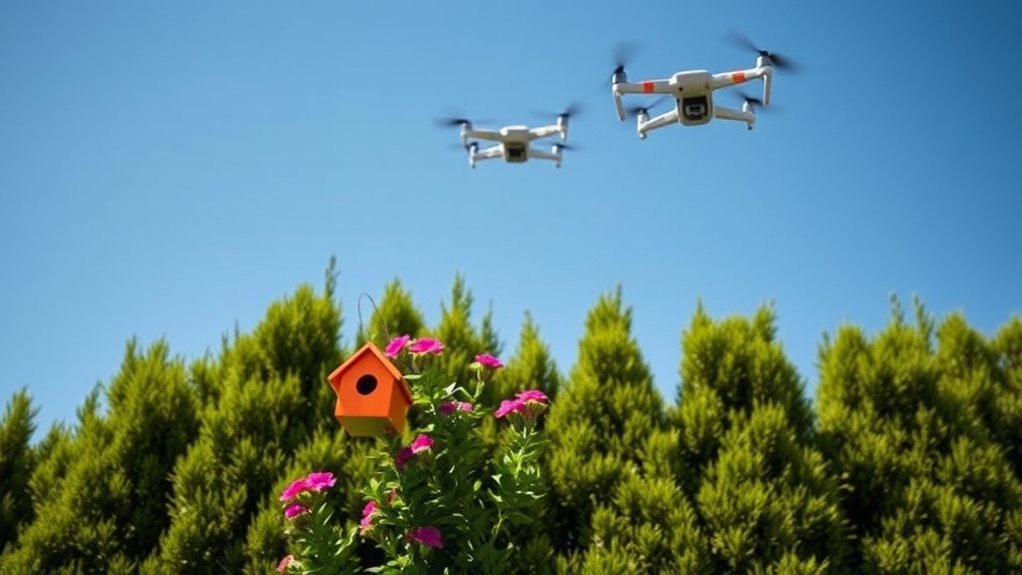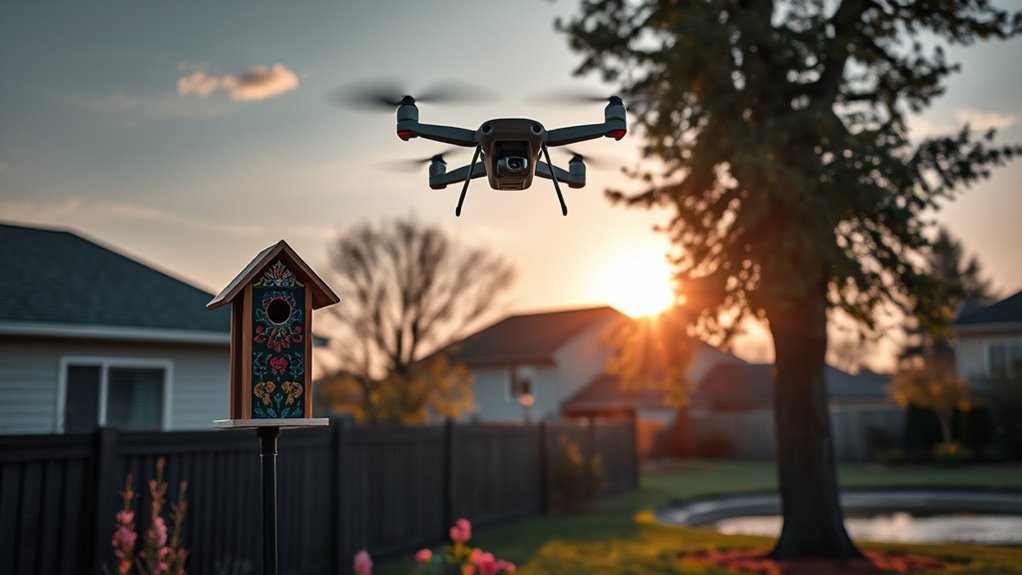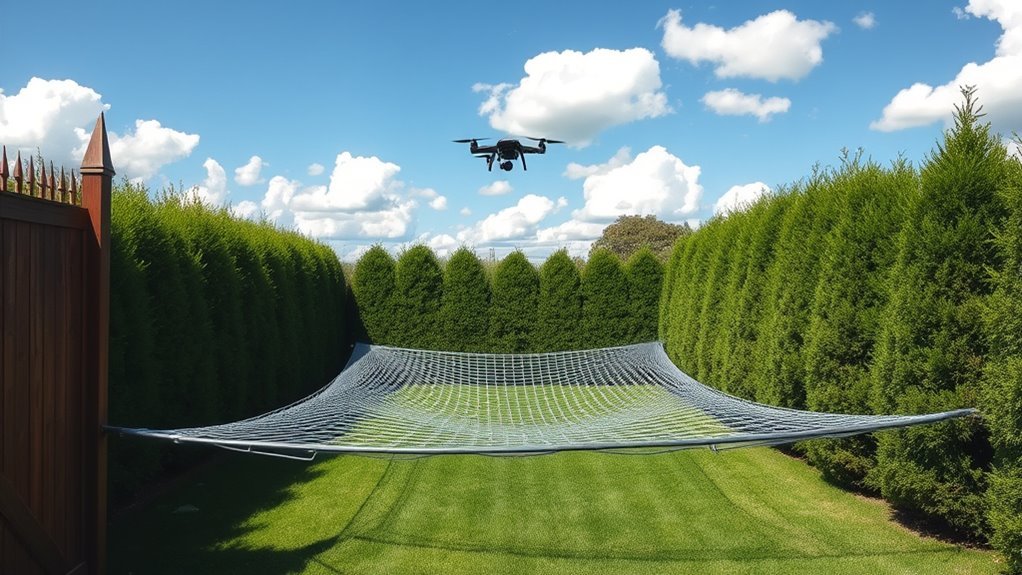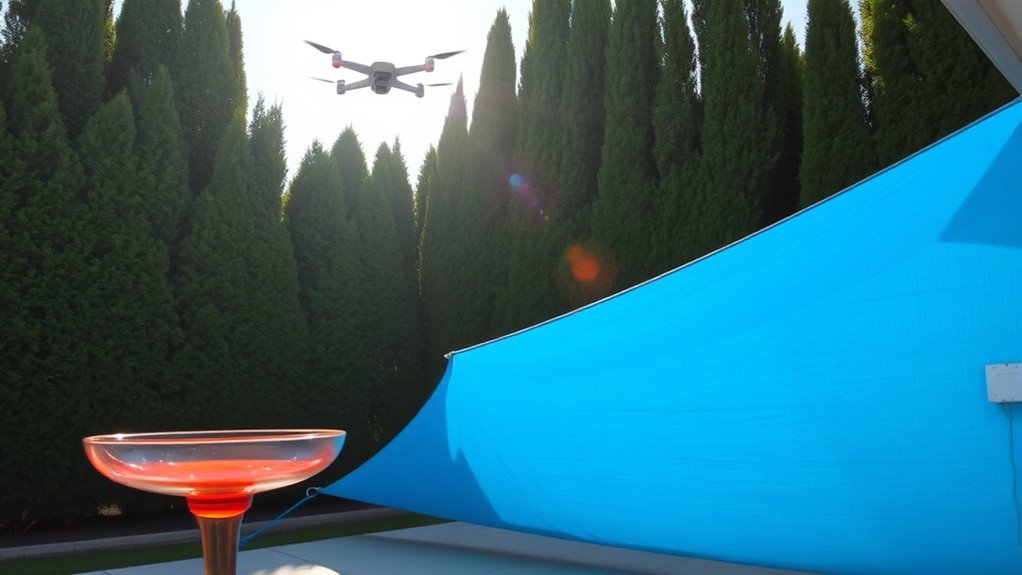To effectively stop drones from flying over your house, consider physical barriers like tall fences or dense foliage that block their line of sight. Employing drone jammers or signal blockers may also deter their operation, but be mindful of legal implications. Strong community action can amplify your voice against unwarranted aerial surveillance. Advocating for local regulations can further enhance your privacy. Explore these strategies to better protect your space and gain insights into broader preventative measures.
Understanding Drone Technology

Drones, or unmanned aerial vehicles (UAVs), have rapidly evolved into sophisticated tools utilized across various sectors, from surveillance to delivery. To understand drone technology, you must grasp the essential drone components, such as the frame, motors, propellers, battery, and sensors. Each plays an important role in drone operation, influencing stability, speed, and payload capacity. For instance, a robust frame supports various attachments, while efficient motors and propellers determine flight performance. Additionally, sensors enhance navigational accuracy and obstacle avoidance, ensuring safe operation. By comprehending these elements, you empower yourself to make informed decisions regarding drone interactions. As drones become more prevalent, understanding their technology will not only foster awareness but also equip you with knowledge to advocate for your rights and freedoms concerning aerial privacy. Moreover, NDAA compliance ensures that certain drones meet stringent security standards, impacting their usage in sensitive environments. Furthermore, the advanced camera capabilities of drones enable users to capture high-quality visuals, enhancing their application in various industries.
Legal Considerations for Drone Deterrence

When considering drone deterrence, it’s essential to understand airspace regulations and how they impact your actions. You need to navigate the complex landscape of privacy rights, as unauthorized interference with drones could lead to legal repercussions. Being informed about these legal frameworks will help you implement effective and lawful deterrent strategies.
Understanding Airspace Regulations
Although the allure of counter-drone technology can be strong, steering through the complex landscape of airspace regulations is vital for anyone considering drone deterrence methods. Understanding airspace classifications is significant, as they dictate where drones can operate legally. Regulatory agencies, such as the FAA, enforce rules that govern drone use in various airspace zones, including controlled and uncontrolled areas. Ignoring these regulations can lead to serious legal repercussions. You must guarantee that any deterrence measures you contemplate comply with local, state, and federal laws to protect your rights without infringing on others’. By maneuvering this regulatory framework carefully, you can effectively pursue your objective of maintaining aerial privacy while remaining within the bounds of legality.
Privacy Rights Considerations
As you consider drone deterrence strategies, it is vital to navigate the intricate landscape of privacy rights. The rise of drone surveillance has raised significant concerns regarding privacy invasion, prompting legal frameworks to evolve. You need to understand that while drones can legally operate in many public spaces, their use for invasive surveillance can breach your rights. Courts have increasingly recognized that individuals have a reasonable expectation of privacy within their own homes, which can limit how drones are utilized. Implementing deterrents requires a balance; while protecting your privacy, guarantee you’re not infringing on the rights of others. Knowledge of local regulations and potential legal implications is fundamental in asserting your rights against unwarranted drone intrusion.
Physical Barriers to Prevent Drone Access

Physical barriers serve as a crucial line of defense against unauthorized drone access, effectively deterring unwanted aerial intrusions. To enhance your privacy, consider various fencing options, such as tall, solid wood or vinyl fences, which can obstruct a drone’s line of sight. Additionally, tree barriers can be strategically planted to create natural obstructions, making it difficult for drones to navigate over your property. Dense foliage not only blocks visual access but also disrupts drone stability in windy conditions. When combined, these physical barriers provide a robust solution against aerial trespassing, ensuring you maintain your freedom and privacy. Ultimately, investing in these barriers empowers you to reclaim your airspace while preserving the tranquility of your home environment.
Using Drone Jammers and Signal Blockers
When considering methods to stop drones, understanding drone jammers and signal blockers is essential. You’ll need to explore the various types of signal blockers available and the legal implications of using them. This knowledge will equip you to make informed decisions in effectively mitigating unwanted drone activity.
Understanding Drone Jammers
Understanding drone jammers and signal blockers is essential for effectively mitigating unauthorized drone activity. These devices utilize advanced drone interference methods and signal disruption techniques to achieve their goals. By blocking communication signals between the drone and its operator, jammers can render drones inoperable within a certain range, protecting your privacy and security.
| Device Type | Functionality | Effective Range |
|---|---|---|
| Drone Jammer | Blocks remote signals | Up to 1 mile |
| Signal Blocker | Disrupts GPS signals | Varies considerably |
| Hybrid Device | Combines both techniques | Up to 2 miles |
Implementing these technologies can enhance your autonomy and guarantee your space remains free from unwanted aerial intrusion.
Types of Signal Blockers
Signal blockers, including drone jammers, come in various types, each designed to target specific communication channels used by drones. These devices employ signal interference techniques that disrupt the signals between the drone and its operator, effectively grounding unwanted aerial intruders. Some jammers focus on specific frequencies, while others provide broader coverage, ensuring extensive protection. Additionally, drone detection devices can be used alongside jammers to identify the presence and type of drones in your vicinity, allowing you to take appropriate action. It’s essential to choose the right combination of blockers to match your needs, ensuring you maintain your freedom and privacy without compromising safety. By understanding these options, you can effectively safeguard your airspace from unwanted drone activity.
Legal Considerations Explained
Although the use of drone jammers and signal blockers can effectively protect your privacy and airspace, it’s important to navigate the legal landscape surrounding their deployment. In many jurisdictions, drone regulations prohibit the use of such devices, as they can interfere with legitimate aviation operations. You should understand that while you seek legal protections for your property, using jammers can lead to significant fines or legal action against you. It’s important to research local laws and consult with legal experts before taking action. Balancing your desire for freedom with compliance to regulations is critical. Ultimately, finding lawful alternatives may offer a better route to safeguard your space without risking legal repercussions.
Deploying Anti-Drone Technology
As concerns over drone misuse grow, deploying anti-drone technology has become essential for guaranteeing safety and security in various environments. You can consider investing in anti-drone systems designed to detect and neutralize unauthorized drones. These systems typically employ advanced sensors and algorithms for effective drone detection, allowing you to identify potential threats swiftly. Options like jamming signals or using net guns can help you regain control over your airspace without compromising your freedom. It’s vital to assess the legal implications of these technologies in your area to guarantee compliance while protecting your privacy. Additionally, understanding local drone regulations is crucial to ensure that the use of such technologies does not lead to legal complications. Ultimately, taking proactive steps with anti-drone technology empowers you to safeguard your property against intrusions, giving you peace of mind in your personal space.
Enhancing Your Property’s Privacy
While deploying anti-drone technology is an effective way to address aerial threats, enhancing your property’s privacy is equally important in today’s surveillance-heavy environment. You can implement privacy enhancing technologies, such as privacy screens and reflective materials, to shield your home from unwanted observation. Strategic landscaping, including tall trees and dense shrubs, can also deter property surveillance by obstructing sightlines. Additionally, consider installing smart privacy solutions like automated blinds that activate at specific times. These measures not only protect your personal space but also send a clear message about your commitment to privacy. By taking proactive steps, you assert your right to freedom from unwarranted intrusion, ensuring your home remains a sanctuary free from prying eyes.
Community Action Against Unwanted Drones
When communities unite to address the issue of unwanted drones, they can create a formidable front against aerial intrusions. Organizing community meetings is essential; these gatherings allow residents to voice concerns, share experiences, and strategize collective action. By fostering dialogue, you can build awareness and consensus on the need for protective measures. Local petitions also play an important role in this process. They not only signal to authorities that this is a pressing issue but also demonstrate community solidarity. When signatures gather, they amplify your voice, compelling local leaders to take action. Ultimately, by working together, you empower yourselves and safeguard your privacy, asserting your right to enjoy your home free from unwarranted surveillance.
Raising Awareness and Advocacy for Drone Regulations
Building on community efforts to combat unwanted drones, raising awareness and advocating for drone regulations are essential next steps. By increasing public awareness about the potential dangers of unregulated drone usage, you empower yourself and your neighbors to take action. Advocacy campaigns play a significant role in this process, as they can effectively communicate the need for regulations that protect your privacy and safety. Engage in discussions with local representatives, join existing advocacy groups, or even start your own campaign. By uniting voices, you can influence policy changes that align with your desire for freedom and personal autonomy. Remember, informed citizens are powerful citizens; your involvement can lead to meaningful change in drone regulation and enhance your community’s well-being. Additionally, understanding federal airspace regulations can help clarify the legal framework surrounding drone operations and strengthen your advocacy efforts. Furthermore, being aware of signal attenuation issues can help in emphasizing the need for regulations that limit drone operations in densely populated areas.
Frequently Asked Questions
What Are the Best Types of Drones to Identify?
To identify drone types effectively, focus on features like size, camera capabilities, and flight range. Understanding these aspects helps you differentiate between recreational and commercial drones, enhancing your ability to assess their presence and purpose.
Can I Report Drone Activity to Local Authorities?
You can report drone activity to local authorities, but understanding reporting procedures and local regulations is essential. Document incidents carefully, and make certain you’re aware of your rights and freedoms regarding privacy and airspace.
How Can I Identify the Owner of a Drone?
To identify a drone’s owner, check its registration number, which is often displayed on the drone. You can contact your local aviation authority for assistance in owner identification based on that registration information.
Are There Specific Laws Against Drone Harassment?
Yes, there’re specific harassment laws addressing drone privacy violations. If a drone invades your space or captures your image without consent, you may have grounds for legal action under these harassment statutes protecting personal liberties.
What Should I Do if a Drone Crashes on My Property?
When a drone crashes on your property, treat it like an uninvited guest. Start with drone recovery tips, ensuring safety first, then conduct a property damage assessment to evaluate any potential liabilities or repairs needed.

